Nội dung của trang này:
Nội dung của trang này:
Pharmacological therapy
POLYCYSTIC OVARIAN SYNDROME
Ovulation induction is part of patient’s management, which aims to
achieve development of a single follicle and subsequent ovulation in a woman with
anovulation
Please see Polycystic Ovarian
Syndrome disease management chart
for further information.
Aromatase Inhibitors
Example drugs: Letrozole, Anastrozole
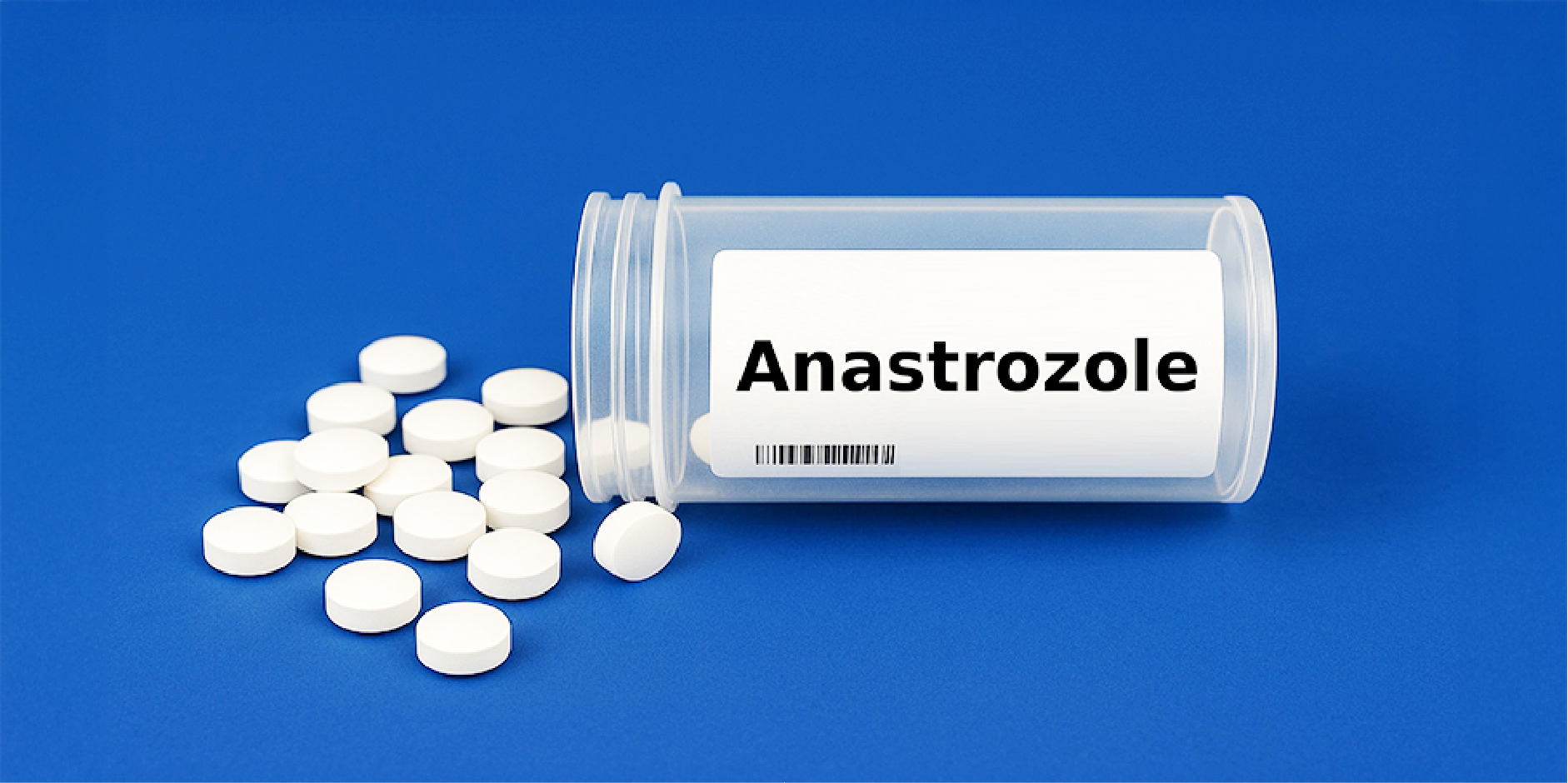 Infertility_Management 1
Infertility_Management 1Aromatase inhibitors inhibit aromatase which converts androgen to estrogen, thus reducing estrogen levels. These increase follicle-stimulating hormone secretion, thereby stimulating ovarian follicle development and maturation. Consider Letrozole as a first-line agent for induction of ovulation in anovulatory women with polycystic ovarian syndrome and with no other factors of infertility to improve ovulation, pregnancy and rates of live births. These appear comparable to Clomifene based on small clinical trials. Studies showed higher live birth and ovulation rates with Letrozole when compared with Clomifene and failure to ovulate is lower with Letrozole compared with Clomifene. These may be used as an alternative in anovulatory World Health Organization class II patients unresponsive to Clomifene. The benefits include its oral administration, a relatively short half-life, a potentially higher implantation rates and a lower multiple pregnancy rates due to monofollicular ovulation. Fetal anomaly rates with these agents are comparable to natural conception or other treatment agents.
Gonadotropins
Gonadotropins may be used as second-line pharmacological therapy in women with polycystic ovarian syndrome with anovulatory infertility and no other infertility factors who failed first-line oral ovulation induction therapy. Gonadotropin monotherapy is preferred over combination therapy with gonadotropin and Clomifene in women with polycystic ovarian syndrome with anovulatory infertility, Clomifene citrate resistance or failure, and without other infertility factors. Gonadotropins alone or with Metformin may be used in anovulatory women with Clomifene resistance and with no other factors of infertility to improve ovulation, pregnancy and rates of live births. These may be preferred over combination therapy with Clomifene and Metformin in women with polycystic ovarian syndrome with anovulatory infertility, Clomifene citrate resistance and without other infertility factors. Gonadotropins may also be preferred over Clomifene citrate in therapy-naive women with polycystic ovarian syndrome with anovulatory infertility and without other infertility factors to improve ovulation, clinical pregnancy and live births.
Higher live birth rate, clinical pregnancy rate per patient and ovulation rate per cycle are observed in women taking gonadotropins compared with Clomifene citrate. If patients fail to ovulate with Clomifene or in patients who ovulate with Clomifene but have failed to conceive, follicle-stimulating hormone with or without luteinizing hormone may be given or laparoscopic ovarian drilling with diathermy may be done. Gonadotropin-induced ovulation should only be performed when there are <3 mature follicles and should be canceled if there are >2 mature follicles and the patient should be advised to avoid unprotected intercourse. Hormonal and sonographic monitoring should be done with gonadotropin therapy to help reduce the chance of multiple gestation and ovarian hyperstimulation.
Follicle-Stimulating Hormone (FSH)
Example drugs: Follitropin alfa, Follitropin beta, Follitropin delta
Follicle-stimulating hormone directly stimulates follicular growth in the ovary. This is available as a variety of formulations that can be derived from recombinant FSH or urinary FSH. Follitropin delta has a lower serum clearance producing greater exposure and pharmacodynamic response and a lesser rate of complications such as ovarian hyperstimulation syndrome (OHSS). This is more suitable to reduce ovarian hyperstimulation syndrome risk.
Luteinizing Hormone (LH)
Luteinizing hormone is co-administered with recombinant follicle-stimulating hormone in anovulatory women with low levels of luteinizing hormone and follicle-stimulating hormone.
Human Menopausal Gonadotropin (hMG)
Human menopausal gonadotropin is available as urinary human menopausal gonadotropin and urinary highly purified human menopausal gonadotropin (HP-hMG). This is a purified extract from human postmenopausal urine and contains both follicle-stimulating hormone and luteinizing hormone. This directly stimulates the ovaries to induce the development and ovulation of follicles. Women who are anovulatory and with no other fertility problems may have similar expectant pregnancy rates just like ovulating women of the same age.
Insulin-sensitizing Agent
Metformin
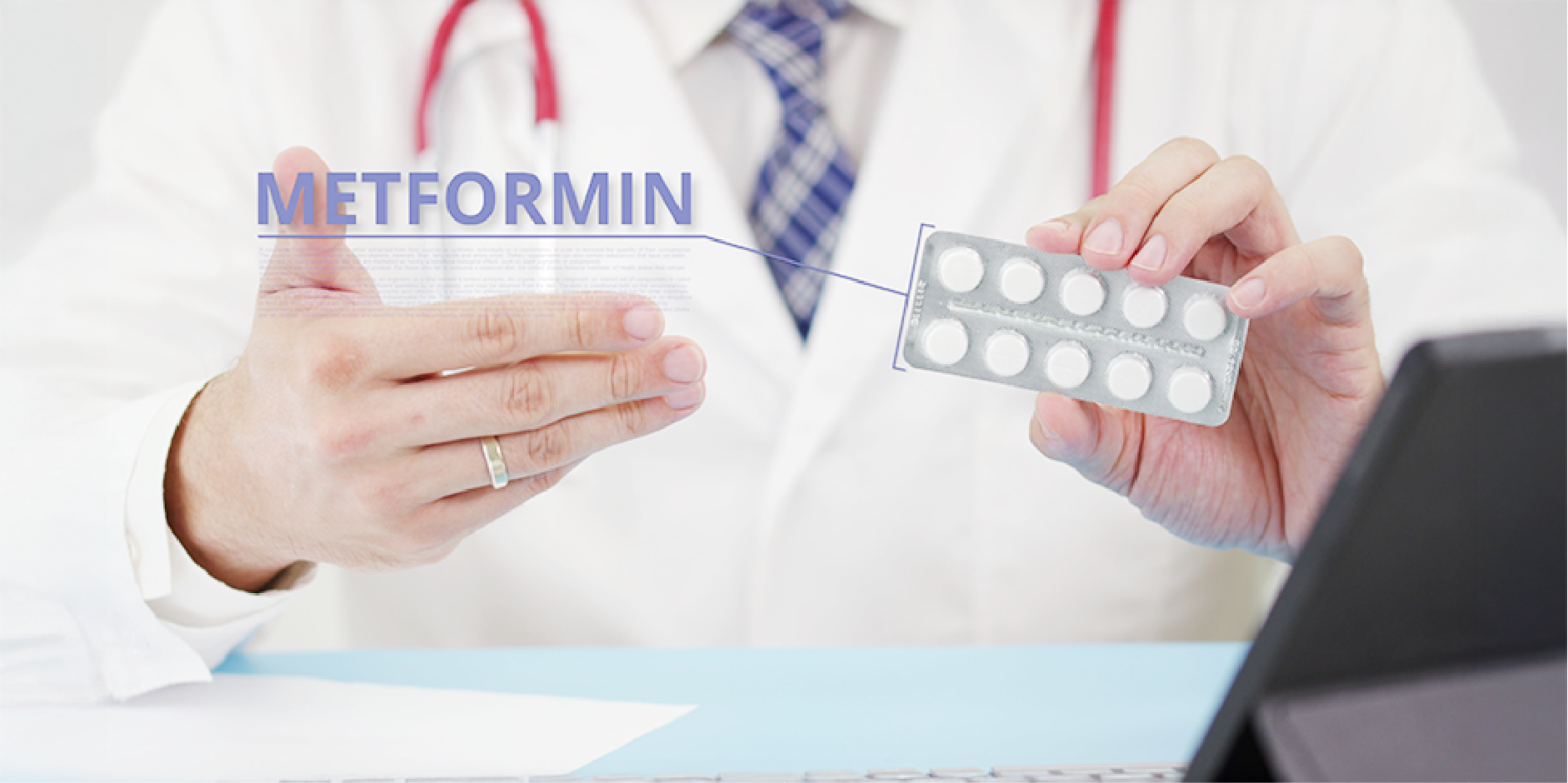 Infertility_Management 2
Infertility_Management 2In hyperinsulinemic polycystic ovarian syndrome, Metformin has been used to restore menstrual cyclicity and induce ovulation with or without the addition of Clomifene. This may be used alone in women with polycystic ovarian syndrome with anovulatory infertility and no other infertility factors to improve ovulation, pregnancy and live birth rates. This may also be given in combination with Clomifene to anovulatory women with polycystic ovarian syndrome and a body mass index of >25 kg/m2 who have not responded to Clomifene alone. This may be given before and/or during follicle-stimulating hormone ovarian stimulation in women with polycystic ovarian syndrome undergoing in vitro fertilization/intracytoplasmic sperm injection therapy with gonadotropin-releasing hormone agonist long protocol to lower the development of ovarian hyperstimulation syndrome and miscarriage. This increases the chance of ovulation and pregnancy. Concomitant treatment with Metformin may enhance the response to gonadotropin treatment or assisted reproduction therapy.
Selective Estrogen Receptor Modulators
Clomifene
Clomifene is an estrogen antagonist that can induce ovulation by raising the levels of follicle-stimulating hormone and luteinizing hormone. This may be used in women with polycystic ovarian syndrome with anovulatory infertility and without other infertility factors to improve ovulation, clinical pregnancy and live birth rates. Approximately 70% of anovulatory women ovulate after Clomifene treatment. Live birth rates after 6 months of treatment with Clomifene range from 15-50%. About 7% of pregnancies are twin pregnancies, 0.5% are triplet pregnancies. Miscarriage rates have been reported at 13-15%. Patients who do not respond to Clomifene are more likely to be more insulin-resistant, obese and more hyperandrogenic compared to those who ovulate. Failure to ovulate at a dose of 150 mg is considered Clomifene-resistant. Depending on the clinical practice, Clomifene may be tried for 6-12 cycles and should not to be used for >6 months. Ultrasound monitoring at least for the first cycle is needed to adjust the dose to minimize the risk of multiple pregnancy. Clomifene combined with Metformin may be used in women with polycystic ovarian syndrome with anovulatory infertility and without other infertility factors to improve ovulation and clinical pregnancy rates. There may be an increase in pregnancy rates by adding Clomifene to Metformin, particularly in obese women or those who are Clomifene-resistant, compared with the use of Clomifene alone, and is based on two meta-analyses.
Tamoxifen
Tamoxifen is an antiestrogen drug widely used in breast cancer treatment that has a similar structure and properties to Clomifene. Pregnancy and ovulation rates have been shown to be similar with Clomifene but the combination of both has no advantage.
HYPOTHALAMIC CAUSES OF OVULATORY DISORDERS
Pulsatile Gonadotropin-releasing Hormone (GnRH)
Pulsatile gonadotropin-releasing hormone is suitable for women with hypothalamic amenorrhea with normal pituitary function in countries where therapy is available. A small mechanical pump is worn by the woman that delivers a pulse of gonadotropin-releasing hormone every 90 minutes. A course of Clomifene therapy may be given before starting the treatment with pulsatile gonadotropin-releasing hormone. Hyperstimulation occurs less often than with human menopausal gonadotropin and therefore less monitoring is required. Many women find the pump cumbersome and prefer human menopausal gonadotropin.
Gonadotropin Therapy
Gonadotropin therapy is an option in women with hypothalamic amenorrhea or hypogonadotropic anovulation with hypopituitarism who cannot obtain pulsatile gonadotropin-releasing hormone therapy. Human menopausal gonadotropin, recombinant FSH and urinary FSH may all be used, but treatment with human menopausal gonadotropin has been reported to be more effective in improving ovulation than follicle-stimulating hormone alone. Gonadotropins with luteinizing hormone activity may be offered for ovulation induction. Hormonal and sonographic monitoring should be done with gonadotropin therapy to help reduce the chance of multiple gestation and ovarian hyperstimulation.
HYPERPROLACTINEMIA
Treatment is directed towards the cause of hyperprolactinemia. If pituitary adenoma and extrapituitary tumors are present, these will need to be managed before proceeding with fertility treatment. In women with clinical evidence of hyperprolactinemia, luteinizing hormone and follicle-stimulating hormone production is reduced and this can be easily treated with medication.
Bromocriptine
Bromcriptine is a dopamine receptor agonist (D2) that inhibits the release of prolactin. Prolactin level normalizes in 70-80% of patients given Bromocriptine. The tumor size decreases in half of the patients with micro and macroadenoma. There is resumption of menses and ovulation in 80-90% of hyperprolactinemic women. An attempt to reduce neonatal exposure to the drug should be done as soon as pregnancy is confirmed and Bromocriptine should be discontinued. During pregnancy, enlargement may occur in 5% of microadenomas and 15-30% of macroadenomas. Prolactin levels rise progressively in pregnancy and monitoring of prolactin levels is not useful. Regular visual field examination throughout pregnancy is recommended. Visual field testing is recommended in patients with macroadenomas. Restart Bromocriptine if tumor growth occurs and explain to the patient the risks and benefits of treatment. Surgical decompression may be done if vision is threatened.
Cabergoline
Cabergoline is useful in patients who are resistant or intolerant to Bromocriptine. There are fewer side effects than with Bromocriptine and can be given 2x/week. This is an ergot derivative with a high selectivity for D2 receptors. If there are no other causes of infertility, 85% of treated women will ovulate and become pregnant. Safety for use in women intending to become pregnant has not been established.
Quinagolide
Quinagolide is a pituitary-selective D2 receptor agonist used in cases of Bromocriptine resistance or intolerance.
OVARIAN CAUSES OF OVULATORY DISORDERS
Gonadotropin-releasing Hormone (GnRH) Antagonists
Gonadotropin-releasing hormone antagonists are associated with shorter treatment length compared to the long gonadotropin-releasing hormone agonist protocol.
Gonadotropin-releasing Hormone (GnRH) Agonists
Gonadotropin-releasing hormone (GnRH) agonists are equally effective with gonadotropin-releasing hormone antagonists.
Mild Stimulation
The use of Clomifene citrate alone or in combination with gonadotropins is recommended for predicted poor responders. A meta-analysis has shown no significant difference for clinical pregnancy rates and live birth rates between the conventional protocol of agonist and the mild protocol of gonadotropins with Clomifene and gonadotropin-releasing hormone antagonist.
Recombinant Luteinizing Hormone (rLH)
Higher clinical pregnancy rates were observed with the combination of recombinant FSH and recombinant LH.
OTHER CAUSES OF INFERTILITY
Cervical Factors
An addition of estrogen prior to ovulation may be beneficial in females who are dealing with any cervical causes of infertility but this lacks clear clinical value.
Endometriosis
Medical suppressive therapies such as oral contraceptives (OCs) or gonadotropin-releasing hormone agonists are not effective in managing infertility due to endometriosis. Gonadotropin-releasing hormone agonist suppression plus addback therapy for 3-6 months given before in vitro fertilization is associated with an improved pregnancy rate.
Please see Endometriosis disease management chart for further information.
Nonpharmacological
Patient Education
Couple Education
 Infertility_Management 3
Infertility_Management 3Inform couples that vaginal sexual intercourse every 2-3 days is the optimal frequency to result in pregnancy. Inform couples that both female and, to a lesser extent, male fertility decreases with age. Emotional support should be provided to the couple because infertility oftentimes produces stress and stress adds to their fertility problems because of decreased sex drive and frequency of intercourse. Encourage the couple to join groups and have counseling. Waiting to have intercourse during ovulation is generally not recommended because it can cause undue stress. If couples find it difficult to have frequent sexual intercourse, luteinizing hormone ovulation kits may be useful for prediction of ovulation.
Lifestyle Modification
Smoking Cessation
 Infertility_Management 4
Infertility_Management 4There is a significant association between decreased fertility and women who smoke. Women who smoke should be made aware that smoking can reduce fertility and should be assisted in smoking cessation. Infertility problems associated with smoking may not be surpassed by assisted reproductive technologies. There is also an association between men who smoke and semen parameters, but the effects on fertility are unknown. Passive smoke may also affect the chances of conceiving.
Moderation of Alcohol Intake
Women who are trying to conceive should be counseled to stop or limit alcohol intake to 1-2 units of alcohol 1-2x/week to reduce the risk of harming a developing fetus. Excessive alcohol intake in men (eg >3-4 units per day) can be detrimental to the semen quality.
Preconceptional Advice
Vaccinations (eg hepatitis B, rubella) are best completed before starting any infertility treatment because some vaccines should not be administered during pregnancy. The rubella status should be checked. Patients should be advised on the use of folic acid 0.4 mg daily while attempting conception. Routinely screen for occupational hazards, use of prescribed, over-the-counter and recreational drugs, and complementary therapy in couples seeking infertility treatment and appropriate advice should be given. A specialist referral may be needed if a woman is 36 years old, there is a positive history of predisposing factors to infertility or a known cause of infertility, or there is a planned treatment that may lead to infertility (eg cancer treatment).
Maintain a Body Mass Index of 19-29 kg/m2
Obesity can affect menstrual function, ovulatory function and oocyte morphology, which can lead to impairment of fertilization and increased rates of miscarriage and obstetric complications. Women with a body mass index of 30 kg/m2 may take longer to conceive. Women with a body mass index of 30 kg/m2 and who are not ovulating should be made aware that if they lose weight, they may increase their chance of conception. Women with a body mass index of <19 kg/m2 with irregular menses or who are not menstruating should also be made aware that if they gain weight, their chance of conception may improve. Men with a body mass index of 30 kg/m2 may have decreased fertility.
Lifestyle Modifications in Women with Functional Hypothalamic Amenorrhea (FHA)
Lifestyle modification should be the initial treatment and must be tailored to the individual patient. Women with a body mass index of <19 kg/m2 and who have irregular menstrual cycles or are not menstruating should be informed that increasing body mass index will likely improve their chance of conception. Stress management and reduction of exercise to a moderate level may assist in the spontaneous recovery of menstrual function.
ASSISTED REPRODUCTION
It is recommended to do an ultrasound between 18 and 22 weeks of gestation to check for congenital structural abnormalities.
Intrauterine Insemination (IUI)
The sample of washed, prepared, motile sperm is deposited in the uterus just before the release of egg or eggs in a natural or stimulated cycle. Higher rates of conception are noted when fresh sperm is used than with frozen-thawed sperm. Consider intrauterine insemination as an alternative to vaginal sexual intercourse in the following groups: People using partner or donor sperm who are unable to or find it difficult to have vaginal sexual intercourse (eg clinically diagnosed physical disability, psychosexual problems); conditions that require specific consideration (eg after sperm washing for HIV-positive men); cervical factor infertility; and same-sex relationships.
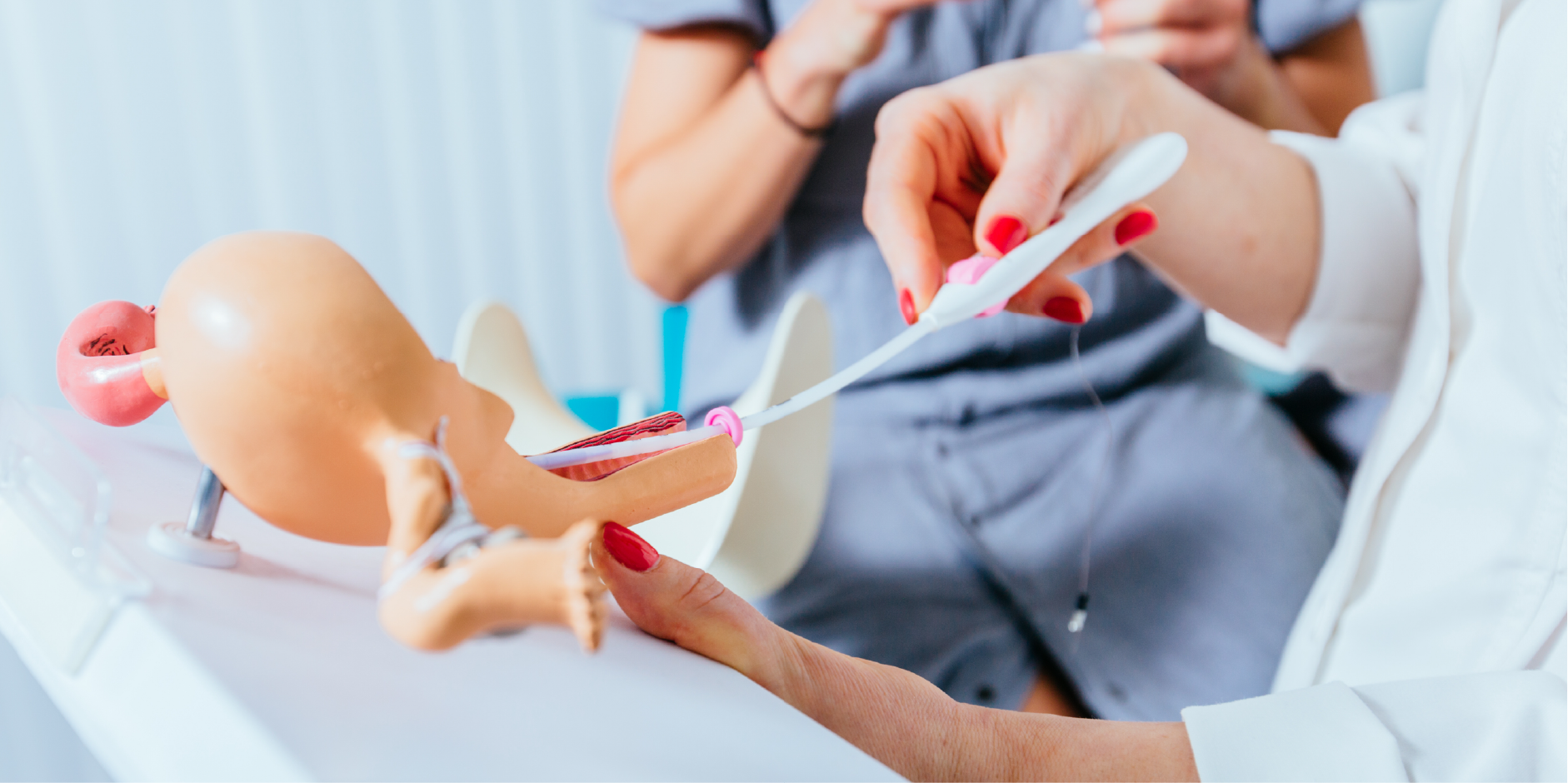 Infertility_Management 5
Infertility_Management 5Intrauterine insemination, with or without ovarian stimulation, should not be routinely offered to patients with unexplained infertility or mild endometriosis who are having regular unprotected intercourse. Couples using artificial insemination to conceive should time the procedure around ovulation. More than 50% of women <40 years old will become pregnant within six cycles of intrauterine insemination; about half of those who did not conceive will become pregnant with another six cycles. Multiple pregnancy is the major risk that may be encountered if ovarian stimulation is used in intrauterine insemination and the cycle is terminated if there are >3 developing follicles.
Polycystic Ovarian Syndrome
Women who have ovulated with Clomifene for 6-12 cycles but have failed to become pregnant should be offered Clomifene-stimulated intrauterine insemination.
Endometriosis
Intrauterine insemination may be used to manage minimal or mild endometriosis. Couples should be informed that ovarian stimulation increases pregnancy rates, but the effectiveness of unstimulated intrauterine insemination is uncertain; still, the pregnancy rate is low after controlled ovarian hyperstimulation-intrauterine insemination in patients with endometriosis. This is done for six cycles with ultrasound monitoring.
Unexplained Infertility
Multifollicular development is induced using Clomifene or gonadotropins (eg follicle-stimulating hormone). Intrauterine insemination with ovarian stimulation using Clomifene citrate is the primary treatment for couples with unexplained infertility. This has been shown to be superior to expectant management and intrauterine insemination without stimulation in terms of live-birth rate outcome. Intrauterine insemination with ovarian stimulation using Letrozole may be used as an alternative regimen for couples with unexplained infertility. Several trials have shown no significant difference in pregnancy rates or multiple-gestation pregnancy rates between intrauterine insemination with Letrozole and intrauterine insemination with Clomifene. Intrauterine insemination with ovarian stimulation with gonadotropin may be an alternative for couples with unexplained infertility. This is associated with a higher pregnancy rate per cycle and a higher multiple pregnancy rate per cycle than intrauterine insemination with Clomifene or Letrozole. Three to six cycles are recommended.
In Vitro Fertilization (IVF)
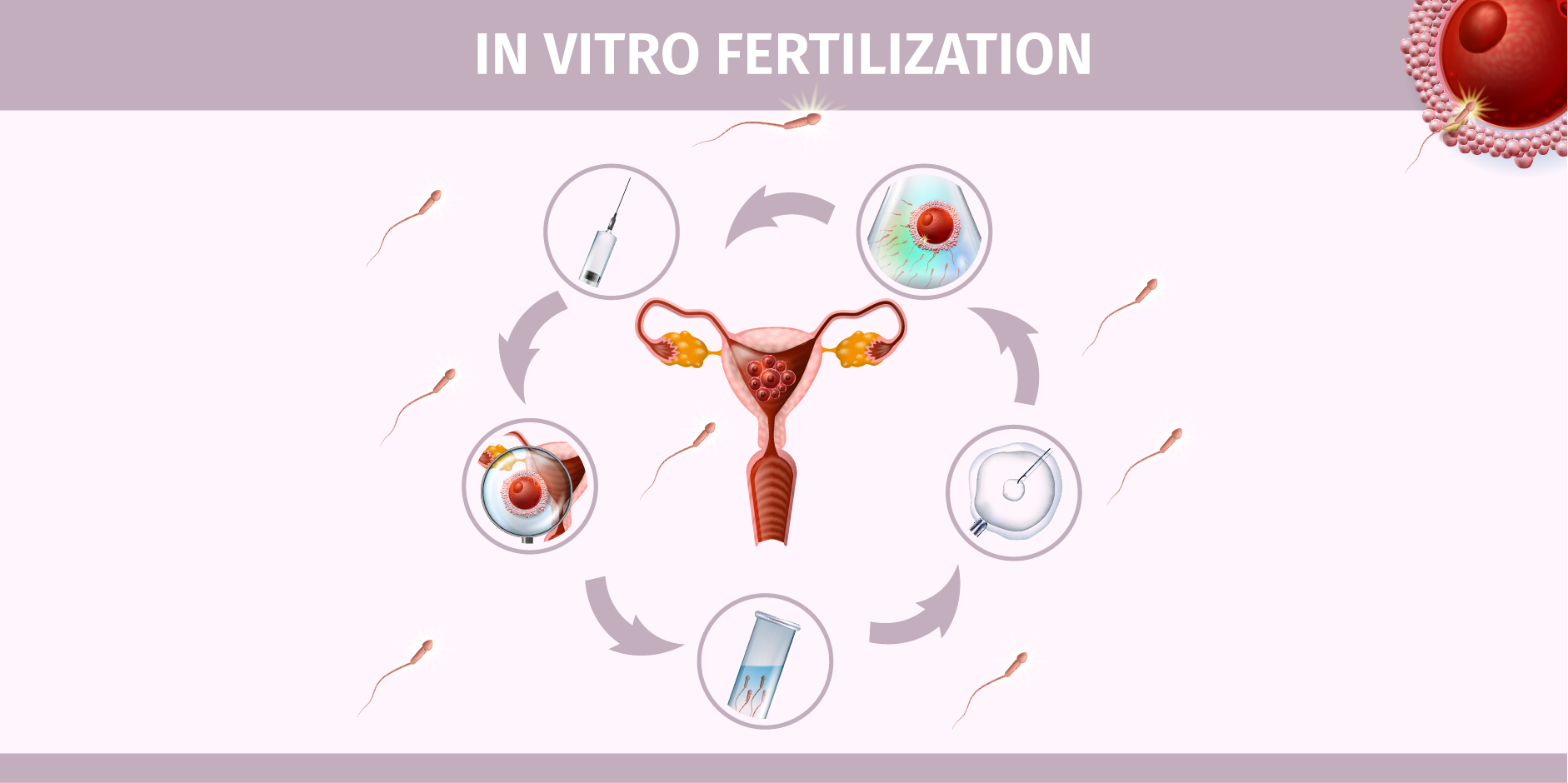 Infertility_Management 6
Infertility_Management 6Patients with unexplained infertility, mild endometriosis, or mild male factor infertility who are having regular unprotected sexual intercourse should try to conceive for 2 years (1 year before fertility investigations included) before considering in vitro fertilization. Indications for in vitro fertilization include severe tubal dysfunction, pelvic anatomy distortion, endometriosis unsuccessfully treated with surgery or medications, unexplained infertility, unsuccessful initial treatment for infertility (eg polycystic ovarian syndrome, hypogonadotropic hypogonadism), and male factor infertility. This may be an option for women with polycystic ovarian syndrome with anovulatory infertility after failure of first- and second-line ovulation induction therapies if without absolute indication for in vitro fertilization/intracytoplasmic sperm injection (ICSI). In vitro maturation (IVM) and intracytoplasmic sperm injection may be considered in women with polycystic ovarian syndrome as an alternative to a stimulated in vitro fertilization/intracytoplasmic sperm injection cycle, where an embryo is frozen and replaced in a subsequent embryo transfer cycle. Intracytoplasmic sperm injection may be used as a method of insemination for patients with unexplained fertility where a previous in vitro fertilization treatment cycle has resulted in total failed fertilization or when a previous in vitro fertilization treatment cycle has resulted in poor fertilization (<25% inseminated mature oocytes achieving normal fertilization).
An in vitro maturation may be an option in women with prior severe ovarian hyperstimulation syndrome and where the risk of severe ovarian hyperstimulation syndrome is unacceptably high. The chance of a live birth after in vitro fertilization is inversely related to the woman's age and the number of failed treatment cycles. In vitro fertilization is more effective in patients who had been pregnant and/or had a live birth. This may also optimize outcomes by removing hydrosalpinges before in vitro fertilization. Immunotherapies (eg granulocyte or granulocyte/macrophage colony-stimulating factor, seminal plasma insemination, IV immunoglobulin, Adalimumab, Tacrolimus, Aspirin, corticosteroids) are either not associated with improved outcomes of live births in in vitro fertilization or have not been sufficiently studied thus patients should be informed of the risks and benefits associated with their use. Normally, a full cycle, with or without intracytoplasmic sperm injection, is made up of one episode of ovarian stimulation and the transfer of any resultant fresh and frozen embryo/s. In vitro fertilization is done for up to three cycles in women who are <40 years who have not conceived after 2 years of regular unprotected intercourse or 12 cycles of artificial insemination; may also be done for up to one cycle in women aged 40-42 years who have not conceived after 2 years of regular unprotected intercourse or 12 cycles of artificial insemination provided that they (1) have never had in vitro fertilization, (2) no evidence of ovarian reserve being low and (3) were informed of the additional implications of in vitro fertilization and pregnancy at this age. HIV, hepatitis B and C tests are done prior to in vitro fertilization to avoid passing these infections to the offspring or to other people and when found to be positive, counseling and treatment are given. Several steps are followed during the in vitro fertilization cycle: Ovarian stimulation, follicular aspiration, oocyte classification, sperm preparation, oocyte insemination, embryo culture, and embryo transfer.
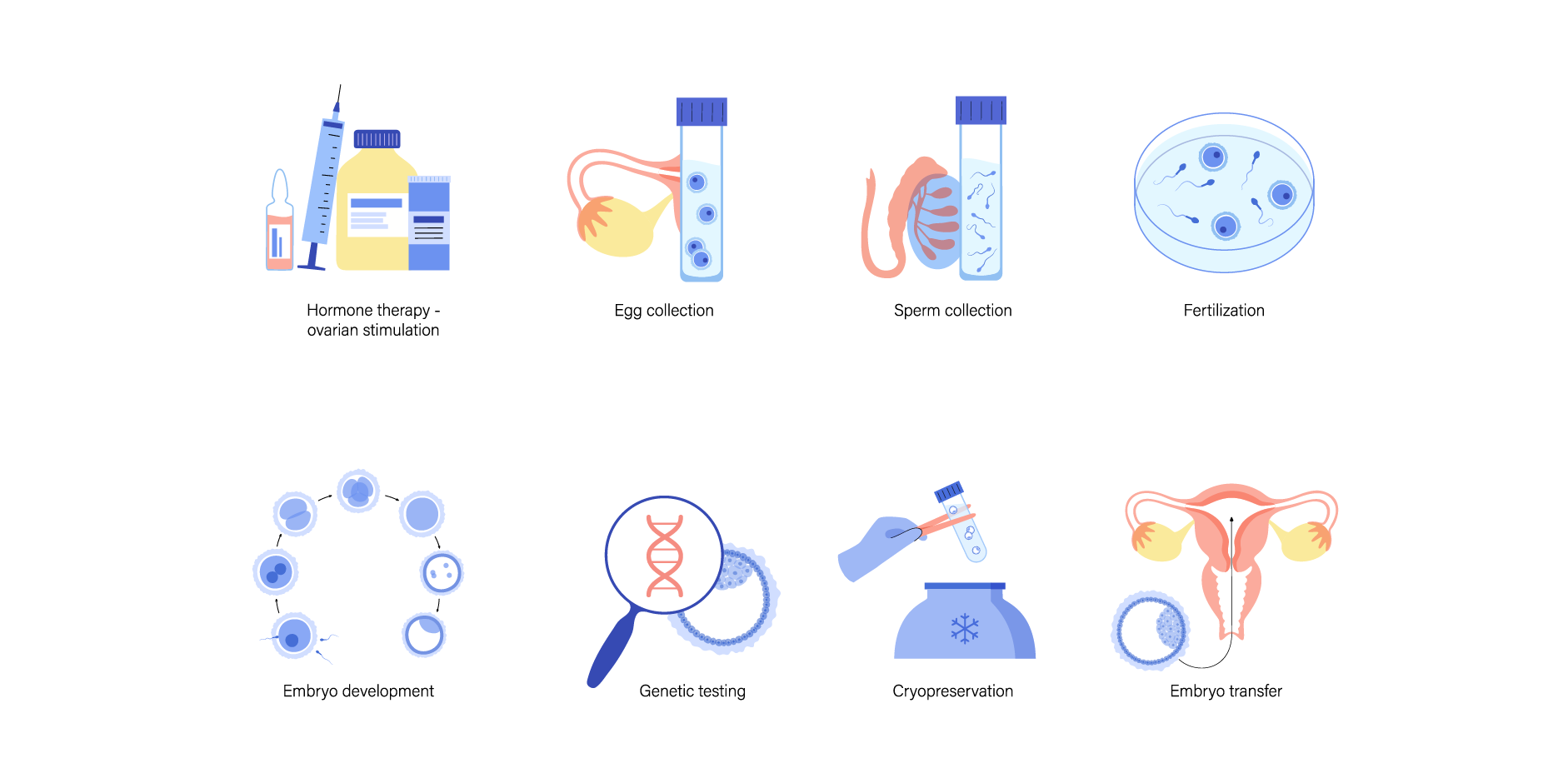 Infertility_Management 7
Infertility_Management 7Ovarian Stimulation
Ovarian stimulation aims to attain a reasonable number of follicles and oocytes by extra ovarian stimulation while minimizing the risk of complications such as ovarian hyperstimulation syndrome. The lowest effective dose and length of use should be used for ovarian stimulation agents. Ovarian response is monitored using ultrasound and serum estradiol level determination. Serum luteinizing hormone level may also be requested.
Clomifene
The protocol for Clomifene consists of 5-7 days of treatment. The disadvantages are low oocyte yield, frequent luteinizing hormone surges, high cancellation rate and low pregnancy rate.
Clomifene and Human Menopausal Gonadotropin (hMG)
The combination of Clomifene and human menopausal gonadotropin may increase the number of recruited follicles. The disadvantages are spontaneous luteinizing hormone surge, high cancellation rate and premature luteinization.
Clomifene, Gonadotropins and Gonadotropin-releasing Hormone (GnRH) Antagonists
Based on a retrospective controlled study, the combination of Clomifene, gonadotropins and gonadotropin-releasing hormone antagonists may increase the pregnancy rate to be comparable to the conventional gonadotropin-releasing hormone agonist long-term protocol, however the ideal protocol for the combination is not yet defined.
Gonadotropins
Use either urinary or recombinant gonadotropins. Recombinant products may be an option for patients with increased risk of complications (eg ovarian hyperstimulation syndrome). Individualize the starting dose based on factors that predict success (eg age, body mass index, presence of polycystic ovarian syndrome) and ovarian reserve. The follicle-stimulating hormone dose should not be >450 IU/day. Low-dose gonadotropins (150 IU/day) with or without oral agents (ie mild ovarian stimulation protocol) may be considered for patients who are poor responders because of comparable low rates of pregnancy and lower costs when compared with conventional in vitro fertilization stimulation protocols. Gonadotropins in combination with aromatase inhibitors are the new ovarian stimulants for in vitro fertilization in women with breast cancer. The disadvantage is a spontaneous luteinizing hormone surge.
Gonadotropin-releasing Hormone (GnRH) Agonists
Gonadotropin-releasing hormone agonists are offered to women with a low risk of ovarian hyperstimulation syndrome. Short-term protocol takes advantage of the flare-up of serum gonadotropins during the follicular recruitment phase and the subsequent down-regulation of the pituitary gland. This may be modified by pretreatment with progestogens during the luteal phase of the cycle preceding in vitro fertilization. Ultra-short protocol involves gonadotropin-releasing hormone agonist administration in the early follicular phase and stopping it after 4-5 days. This relies on the strategy that the initial administration will lead to slight, but prolonged, suppression of the exogenous luteinizing hormone surge. Long-term protocol induces pituitary and ovarian desensitization in the early follicular or midluteal phase of the cycle preceding the planned in vitro fertilization. This is recommended over short or ultra-short protocol due to higher efficacy. The combination of Norethisterone acetate or oral contraceptives with gonadotropin-releasing hormone agonist is effective in preventing the formation of ovarian cysts and the chance of having a live birth is not affected by pretreatment with a progestogen or an oral contraceptive. Gonadotropin-releasing hormone agonists in combination with gonadotropin stimulation produce higher pregnancy rates when compared to gonadotropins used alone. The use of gonadotropin-releasing hormone agonists to trigger final oocyte maturation and freezing all suitable embryos is recommended in an in vitro fertilization/intracytoplasmic sperm injection cycle with a gonadotropin-releasing hormone antagonist protocol in women with increased risk of ovarian hyperstimulation syndrome or when fresh embryo transfer is not intended. The use of gonadotropin-releasing hormone agonist may require luteal phase support. The potential risks and disadvantages are ovarian hyperstimulation syndrome risk secondary to excessively high estradiol levels, increased multiple pregnancy, and cost due to increased requirements of gonadotropins and longer duration of therapy.
Gonadotropin-releasing Hormone (GnRH) Antagonists
Example drugs: Cetrorelix, Ganirelix
Gonadotropin-releasing hormone antagonists block the luteinizing hormone surge at the preovulatory period, hence premature luteinization does not occur. Monitoring of luteinizing hormone and progesterone may be helpful for optimal guidance. Gonadotropin-releasing hormone antagonist protocol is recommended in women with polycystic ovarian syndrome undergoing in vitro fertilization/intracytoplasmic sperm injection due to the use of an agonist trigger and the possibility of freezing all embryos generated without compromising the cumulative live birth rate and it reduces the risk of significant ovarian hyperstimulation syndrome but is not recommended over gonadotropin-releasing hormone agonist long protocol. The advantages are shorter treatment protocol without initial flare-up effect, reduced overall cost due to lower amount of total gonadotropins needed for ovulation stimulation, shorter period of gonadotropin stimulation, reduced risk of severe ovarian hyperstimulation syndrome, and avoidance of cyst formation. This is administered when the largest follicle reaches 14 mm or when serum luteinizing hormone levels are >10 mIU/mL. Cetrorelix, a third-generation gonadotropin-releasing hormone antagonist, is used for ovarian stimulation. Two preparations are available for optimal tailoring to individual patients’ needs. They may also use Ganirelix for ovarian stimulation. The multiple-dose protocol involves daily injections of low-dose gonadotropin-releasing hormone antagonists from day 6 of ovarian stimulation. In the presence of a premature luteinizing hormone surge, Cetrorelix 0.25 mg is started earlier. Cetrorelix 3 mg is recommended provided that Cetrorelix 0.25 mg was given <4 days. Patients who show poor response may benefit from the addition of rLH in a multiple-dose protocol, or may choose other alternative stimulation protocols. Single-dose protocol involves administration of gonadotropin-releasing hormone antagonists during the late follicular phase. Addition of rLH or the use of human menopausal gonadotropin is not necessary.
Human Chorionic Gonadotropin (hCG)
Human chorionic gonadotropin is used to induce final follicular maturation and to trigger ovulation. Recombinant hCG provides similar outcomes with urinary preparation in terms of oocyte numbers and pregnancy rates, higher progesterone levels in the luteal phase, and reduced incidence of local injection site reactions. Lowest doses should be used to trigger final oocyte maturation in women with polycystic ovarian syndrome undergoing in vitro fertilization to reduce the incidence of ovarian hyperstimulation syndrome.
Human Menopausal Gonadotropin (hMG)
Human menopausal gonadotropin may be an option for ovarian stimulation.
Trophic Hormones and Related Synthetic Drugs
Example drug: Corifollitropin alfa
Trophic hormones are used in combination with a gonadotropin-releasing hormone antagonist for the development of multiple follicles in women in an assisted reproduction techniques (ART) program. This effectively replaces the first seven daily doses of recombinant FSH in controlled ovarian stimulation (COS) cycles.
Follicular Aspiration
Transvaginal follicular aspiration guided by ultrasound is done 35-36 hours after human chorionic gonadotropin administration.
Oocyte Classification
Oocyte classification is an important step for in vitro fertilization success. Oocytes are graded based on the corona-cumulus complex appearance.
Oocyte Insemination and Embryo Culture
Each oocyte is inseminated with 50,000-100,000 motile, morphologically normal sperms. Ideally, the presence of two pronuclei and the extrusion of the second polar body are the criteria required to determine fertilization and fertilization usually occurs 12-20 hours after insemination. Embryos or fertilized oocytes are transferred into growth media and are incubated.
Embryo Transfer
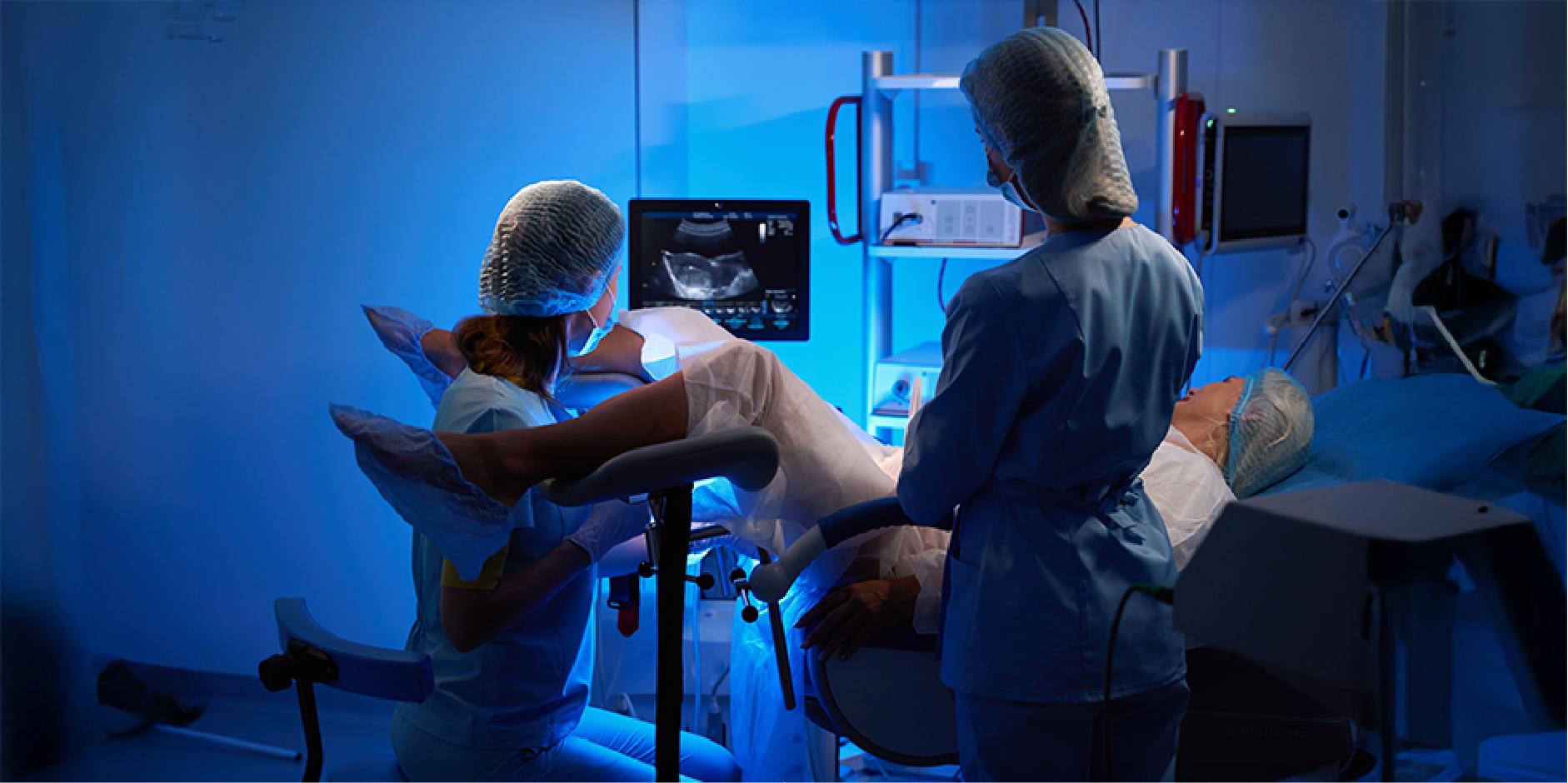 Infertility_Management 8
Infertility_Management 8Embryos are transferred transcervically under transabdominal ultrasound. For women <37 years: Use one embryo transfer in the first full cycle; one embryo if 1 top-quality embryo is available or two embryos if there are no top-quality embryos in the second cycle; and no more than two embryos in the third cycle. For women aged 37-39 years: Use one embryo transfer in first and second cycles if 1 top-quality embryo is available; if no top-quality embryos, consider two; and no more than two embryos in the third cycle. For women aged 40-42 years: Consider a double embryo transfer. There is a maximum of two embryo transfers per cycle and one embryo if a top-quality blastocyte is available. The risk of multiple gestation is associated with double embryo transfer.
Luteal Support
Progesterone is recommended for luteal phase support following in vitro fertilization/intracytoplasmic sperm injection. During the luteal phase, progesterone is administered 72 hours after oocyte aspiration and continued for about 2 weeks and it is not necessary beyond 8 weeks of gestation. Several routes of progesterone delivery are suggested (oral, intramuscular and vaginal) but the vaginal route offers several advantages. Avoid routinely offering human chorionic gonadotropin for luteal support as it increases the likelihood for ovarian hyperstimulation syndrome.
Cryopreservation
Cryopreservation may be done to good-quality embryos remaining after the embryo transfer for future use. Increasing evidence shows that outcomes of pregnancy with cryopreserved embryos fertilized in vitro are better than for fresh embryo transfers. It makes future assisted reproductive technology cycles simpler, less invasive and less expensive compared to the initial in vitro fertilization cycle. This is an option for couples prior to starting chemotherapy or radiotherapy that will likely make them infertile. In preserving fertility in people with cancer, sperm, oocytes or embryos may be cryopreserved. This is offered to men and adolescent boys prior to treatment for cancer that will make them infertile. Offer oocyte/embryo cryopreservation to women and adolescent girls prior to cancer treatment that will make them infertile they are well enough for ovarian stimulation and egg collection without making their condition worse and if there is enough time before they start the cancer treatment. The initial cryopreservation period is 10 years and can go beyond this for men who remain at risk for infertility.
Gamete Intrafallopian Transfer (GIFT)
Gametes are transferred to the woman’s fallopian tubes rather than her uterus and fertilization occurs in the fallopian tubes rather than in the laboratory. This is an alternative for women who have normal fallopian tubes. The use is limited because fertilization cannot be confirmed and there is insufficient evidence to recommend use in couples with unexplained fertility problems and male fertility problems in preference to in vitro fertilization.
Zygote Intrafallopian Transfer (ZIFT)
Fertilization happens in the laboratory and then the zygote is transferred to the fallopian tube by laparoscopy. The use is limited, as there is insufficient evidence to recommend use in couples with unexplained fertility problems and male fertility problems in preference to in vitro fertilization.
Oocyte Donation
Oocyte donation is considered in patients with ovarian causes of ovulatory disorders (premature ovarian insufficiency, gonadal dysgenesis [eg Turner syndrome], following chemotherapy or radiotherapy), bilateral oophorectomy, certain cases of failure with in vitro fertilization treatment and genetic disorders.
Phẫu thuật
Polycystic Ovarian Syndrome (PCOS)
Laparoscopic
Ovarian Drilling with Diathermy
Laparoscopic
ovarian drilling with diathermy is also known as laparoscopic ovarian surgery.
This may be used as second-line therapy in women with polycystic ovarian
syndrome with anovulation, infertility, Clomifene citrate resistance and those without
other infertility factors. This may be used to induce ovulation in
Clomifene-resistant polycystic ovarian syndrome. This creates several surface
lesions on the ovary that may trigger endocrine changes and induce ovulation. Cumulative
pregnancy with this technique was found equivalent to ovulation induction with
gonadotropins but is not associated with increased risk of multiple pregnancy.
Cervical Factors
Infertility
due to stenosis of the cervical canal can be managed with dilatation. Removal
of cervical polyps is done by polypectomy and abrasion of the cervical canal.
Endometriosis
Laparoscopy
is the surgical approach of choice in treating infertility secondary to
endometriosis. This aims to remove endometriotic lesions, restore normal
anatomy with adhesiolysis, and optimize ovarian and tubal preservation. This improves
the pregnancy rate of patients with minimal or mild endometriosis regardless of
treatment modality. Laparoscopic excision of >3-cm ovarian endometrioma may
improve fertility. This technique is more effective than simple drainage and
ablation of the cyst wall. The removal of deeply infiltrating endometriosis may
unfavorably affect fertility. The patient should be advised to undergo in
vitro fertilization after an initial unsuccessful surgery for
endometriosis-associated infertility rather than reoperation unless pain is
still a concern.
Tubal Dysfunction
If
tubal surgery is effective, it may allow patients to conceive naturally without
further intervention. The outcome depends on the severity of tubal damage, the duration
of infertility, associated infertility factors, training, and the experience of
the surgeon.
Fimbrioplasty
and Neosalpingostomy
Fimbrioplasty
and neosalpingostomyurgical are surgical procedures for improving the patency
of the distal tubal obstruction. These should be done via laparoscopy only due
to the reduced risks and comparable results with laparotomy. Salpingostomy
performed before an in vitro fertilization may improve the subsequent
likelihood of success of in vitro fertilization in older women with mild
hydrosalpinges, in male factor infertility or in other infertility factors.
Tubal
Microsurgery and Laparoscopic Tubal Surgery
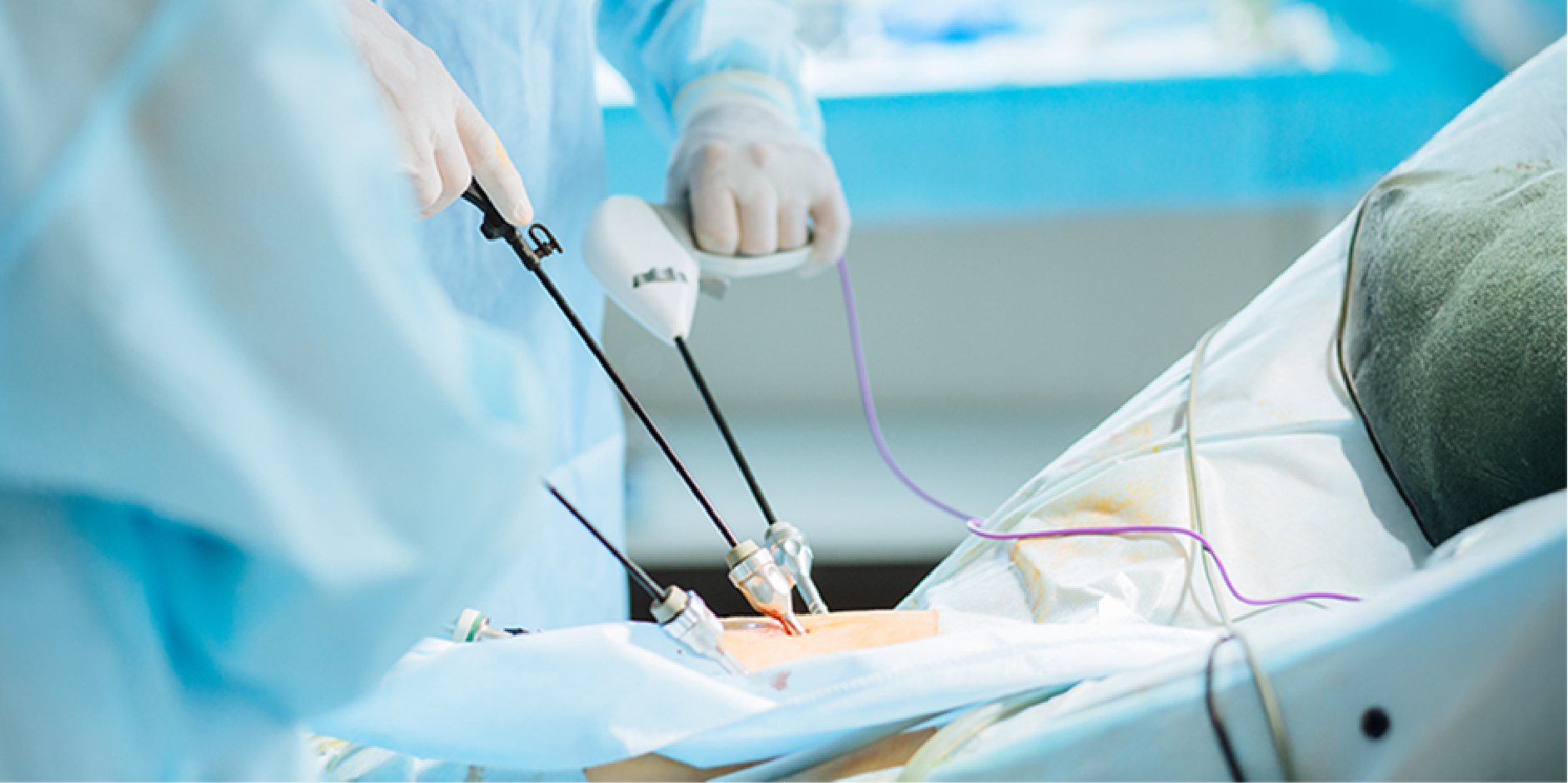 Infertility_Management 9
Infertility_Management 9Tubocornual anastomosis is the standard procedure for proximal tubal blockage. In centers with appropriate expertise, tubal surgery offers higher pregnancy rates in patients with tubal infertility. Surgery is more effective in those with mild tubal disease than no treatment. Laparoscopic adhesiolysis is as effective as microsurgical adhesiolysis in improving pregnancy outcome.
Tubal Catheterization or Cannulation
Tubal catheterization or cannulation is a procedure that uses either a radiographic approach (selective salpingography with tubal cannulation) or a hysteroscopic tubal cannulation. This is the preferred procedure for women with proximal tubal obstruction. Selective salpingography with tubal catheterization or hysteroscopic tubal cannulation may improve the chance of pregnancy in women with proximal tubal obstruction.
Uterine Abnormalities
Surgical correction of polyps, adhesions, fibroids, or septa appears to improve pregnancy rates. Hysteroscopic polypectomy of endometrial polyps has been shown to improve pregnancy rates. Fibroid removal is not clearly associated with improvement of fertility treatment outcomes. Hysteroscopic or laparoscopic myomectomy of submucous or endometrial cavity-distorting leiomyomas has a modifiable effect on fertility. Hysteroscopic adhesiolysis is likely to restore menses and improve chances of pregnancy in amenorrheic women with intrauterine adhesions.
Please see Leiomyomas disease management chart for further information.
